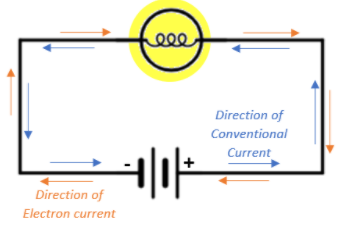
Conventional current is the direction of electric current from the positive terminal of a cell to the negative terminal.
A.True
B.False
Answer
452.7k+ views
Hint: Recall that the flow of electric current in a circuit is caused by the flow of electrons from the anode to the cathode of a battery. Also, electric current defines the direction of flow of positive charges in a circuit. Use this to arrive at the appropriate direction of flow of conventional current given that charge carriers always flow from a region of high concentration to a region of low concentration.
Complete answer:
Let us begin by first understanding what electric current is, following which we shall define what conventional current is and how it is different from other types of electric current.
An electric current is essentially a stream of charged particles moving through an electrical conductor, and is measured as the rate of flow of electric charge over a particular region. These moving charged particles are called charge carriers. Based on the type of charge carriers, electric current flowing through a conductor can be classified into:
1.Electron Current
2.Conventional Current

We know that when a battery is connected across a circuit with a bulb as shown above, the purpose of the battery is to establish a potential difference across the circuit. Chemical reactions in the battery cause a build-up of electrons or negative charges at the anode, and positive charges at the cathode.All charges naturally tend to flow from a region of higher concentration to a region of lower concentration and this difference in concentration is nothing but the potential difference across a circuit, so, electrons flow from negative terminal of the battery to the positive terminal and constitute the electron current whereas positive charges move in an opposite direction and constitute the conventional current.
Thus, conventional current is nothing but the electric current that flows from the positive terminal of a battery to the negative terminal.
Therefore, the correct choice would be A. True
Note:
It is important to understand that the electric current in a circuit arises only from the flow of electrons and not from the flow of positively charged particles. Thus, conventional current is defined as if the movement of positive charge carriers constitute electric current flow when it is in fact not the case. This is because the idea of conventional current was established prior to the identification of electricity with electrons, and a convention was required to define the direction of current flow. But we now know that it is not the positive charges but the electron flow from the negative to the positive terminals of the battery that causes electric current to flow from the positive to the negative terminals of a battery.
Complete answer:
Let us begin by first understanding what electric current is, following which we shall define what conventional current is and how it is different from other types of electric current.
An electric current is essentially a stream of charged particles moving through an electrical conductor, and is measured as the rate of flow of electric charge over a particular region. These moving charged particles are called charge carriers. Based on the type of charge carriers, electric current flowing through a conductor can be classified into:
1.Electron Current
2.Conventional Current

We know that when a battery is connected across a circuit with a bulb as shown above, the purpose of the battery is to establish a potential difference across the circuit. Chemical reactions in the battery cause a build-up of electrons or negative charges at the anode, and positive charges at the cathode.All charges naturally tend to flow from a region of higher concentration to a region of lower concentration and this difference in concentration is nothing but the potential difference across a circuit, so, electrons flow from negative terminal of the battery to the positive terminal and constitute the electron current whereas positive charges move in an opposite direction and constitute the conventional current.
Thus, conventional current is nothing but the electric current that flows from the positive terminal of a battery to the negative terminal.
Therefore, the correct choice would be A. True
Note:
It is important to understand that the electric current in a circuit arises only from the flow of electrons and not from the flow of positively charged particles. Thus, conventional current is defined as if the movement of positive charge carriers constitute electric current flow when it is in fact not the case. This is because the idea of conventional current was established prior to the identification of electricity with electrons, and a convention was required to define the direction of current flow. But we now know that it is not the positive charges but the electron flow from the negative to the positive terminals of the battery that causes electric current to flow from the positive to the negative terminals of a battery.
Recently Updated Pages
Master Class 10 General Knowledge: Engaging Questions & Answers for Success

Master Class 10 Computer Science: Engaging Questions & Answers for Success

Master Class 10 Science: Engaging Questions & Answers for Success

Master Class 10 Social Science: Engaging Questions & Answers for Success

Master Class 10 Maths: Engaging Questions & Answers for Success

Master Class 10 English: Engaging Questions & Answers for Success

Trending doubts
A boat goes 24 km upstream and 28 km downstream in class 10 maths CBSE

Why is there a time difference of about 5 hours between class 10 social science CBSE

The British separated Burma Myanmar from India in 1935 class 10 social science CBSE

The Equation xxx + 2 is Satisfied when x is Equal to Class 10 Maths

Chandigarh is the capital of A Punjab B Haryana C Punjab class 10 social science CBSE

Change the following sentences into negative and interrogative class 10 english CBSE




